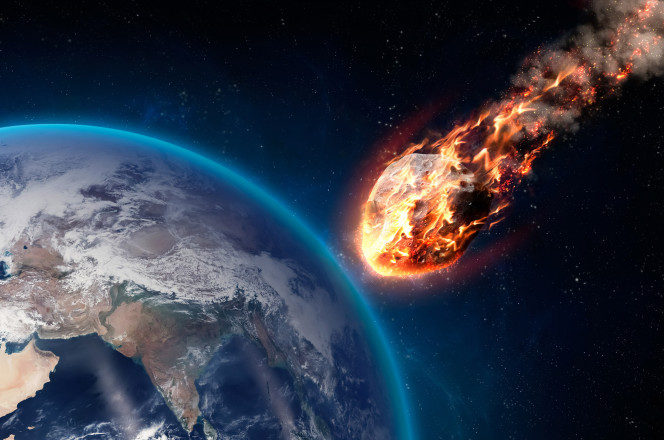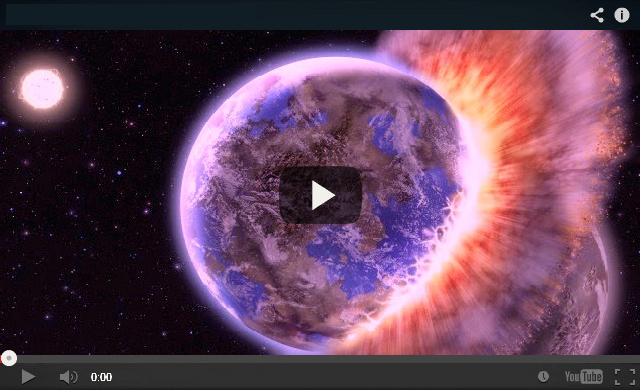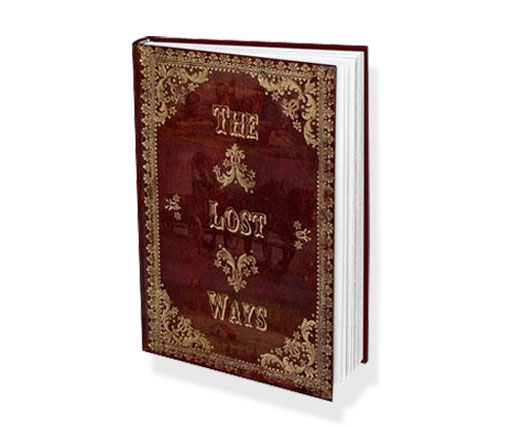A large asteroid colliding with the Earth can cause immediate destruction resulting in mass extinction. An asteroid called the Apohis Asteroid may be on a collision course with Earth. Impact Date: 2036. Any way to survive?
An asteroid named 2004 MN4, the “Apophis Asteroid” had been assigned the highest odds ever for a direct impact with our planet since we’d started documenting asteroids in near-Earth orbits. At first, observations guessed at a possible meeting date in the year 2029. Later it was determined that 2029 would probably go off without much problems from 2004 MN4.
However, in 2036 we weren’t so sure.Back in 2005, the chances for impact were noted to be only 1-in-10,000. Further, Schweikart also indicated that the asteroid would be out of sight from 2006 to 2012; but when it reappeared, the chances for collision would probably be set to zero.
Still, likely isn’t the same as definitely. Along with this, the world still needs to be concerned.
Will 2036 Asteroid Strike Earth? Current Estimates
Current guesstimates show that there is a 1-in-43,000 chance that the aforementioned asteroid could cross paths with our planet in 2036. Due to this, a group of scientists, engineers, and astronauts early this year called on the United Nations to take both the 2036 asteroid threat as well as global asteroid concerns more seriously.Meaning that the world should document an international plan to deflect, dismantle, or otherwise deal with asteroids right now before it was too late.
By the way, the steroid 2004 MN4 is now commonly referred to as Apophis.
“It’s not just Apophis we’re looking at. Every country is at risk. We need a set of general principles to deal with this issue,” Schweickart, a member of the Apollo 9 crew that orbited the Earth in the 1960’s, told a conference in San Francisco.
Obviously, to date, there is no plan to deal with an asteroid threat, U.S. or otherwise.
Schweikart has already presented an update to the U.N. Committee on Peaceful Uses of Outer Space. More specifically, he plans to discuss the need to develop a blueprint to deal with Apophis and other asteroid threats with them.
Along with this, The Association of Space Explorers, a group of former astronauts and cosmonauts, plans on holding a series of workshops in 2007 to further delve into the formulation of a possible plan with a target date of formal proposal to the U.N. in 2009.
Though this is all great news, a possible asteroid impact clearly isn’t. Further, a relatively recent congressional mandate for NASA to upgrade its ability to follow and track asteroids in the solar system is expected to further identify thousands of killer rocks in space.
So that brings up two questions: What would happen if one hit; and what can we do about it, if anything?
What to expect from an asteroid impact
Let’s put it this way. Don’t expect anything good.For an example of the devastation that could be caused, we must look to the Earth’s hypothesized history. It is widely believed that a huge 10 kilometer asteroid set down in what is now the Yucatan Penninsula of Mexico about 65 million years ago. This collision formed the Chicxulub Crater that can be seen below the pennisula; an ancient crater approximately 180 kilometers wide. Now that’s the small stuff.
The impact from this event is also hypothesized to have wiped out the dinosaurs and destroyed the majority of plant and animal life beyond our enormous predecessors on the planet.
Said another way, the force from the asteroid’s impact would’ve been approximately 2,000,000 times more powerful than the most powerful explosive device ever detonated. Thus, it would have almost certainly served to unleash some of the largest megatsunami’s in the Earth’s history. Further, the emission of dust and particles likely shrouded the planet in darkness for many years. In essence, the effect would’ve been much like a nuclear winter.
Ouch.
That said, much smaller asteroids have shown the ability to be quite destructive on their own. For example, an asteroid that touched down in Winslow, Arizona roughly 50,000 years ago is hypothesized to have unleashed the equivalent energy of 500 Hiroshima bombs.
And that’s just asteroids. Try on comets for a moment. Back in 1908, a mere 50 meter piece of comet touched down in Siberia. Though no crater formed, the blast was the equivalent of 600 Hiroshima bombs and leveled everything- plants, trees, land: everything- for miles around.
Lucky it landed in such a relatively barren area.
By the way, Apophis is approximately 250 meters long.
Here’s the first piece to the puzzle: detection.
Obviously, in order to protect ourselves, we need to know that an asteroid is coming. Most researchers seem to agree that for a relatively large asteroid (200-300 meters long) we’d have to know years in advance for any deflection strategy to work. Thus the reason why various researchers and citizen groups have requested that Congress (and now) the United Nations do a better job with detection. In fact, back in 1990 Congress authorized better detection of such events to NASA by writing that it was, “imperative that detection rate of Earth-orbit-crossing asteroids must be increased substantially and that means to destroy or alter the orbits. . . should be defined and agreed internationally.”That said, on January 7, 2002, a huge asteroid known as 2001 YB5 passed very close to our planet. The problem? We didn’t know about it until mere weeks before the occurrence.
Still, there have been huge improvements in national and international detection of NEO’s. Further, there have even been efforts made- such as with the Deep Impact Probe- to see what asteroids or comets are made of in the hopes that this might help us to determine a course of action to deal with them. Which, of course, leads to the following.
What do we do if we find that an asteroid is likely to impact Earth?
First, if we know where one is going to roughly set down and haven’t already deflected, we should run!No, that’s not an attempt to be funny. Anyone and anything near an impact site would likely be obliterated, even if a smaller asteroid sets down. Thus, the first order of defense would be a coordinated evacuation.
However, once the asteroid sets down there is sure to be terrible damage. Thus, here are several deflection type strategies that have been discussed in the hopes that we can avoid such tragedy.
Nuclear Impact – Simply put, we could fire nuclear weapons at an asteroid approaching Earth in the hopes of vaporizing it. This is the most well-known and discussed theory to deal with an asteroid intent on doing harm.
However, there are clearly risks. First, we do not currently have any nuclear bombs capable of vaporizing an asteroid as large as one kilometer. However, theoretically we could- if sufficient materials exist- make a thermonuclear bomb that could do the job.
Of course, that’s only theoretically.
The second risk is a bit more problematic, however. What if the asteroid, as a result of being hit with a nuclear bomb, breaks into pieces? This would, in fact, make it even more difficult to evacuate and project the course of the pieces intent on doing Earth harm.
Third, rubble pile asteroids would be near impossible to vaporize in such a fashion due to their composition.
Nuclear Propulsion – This idea incorporates the possibility of detonating several nuclear blasts close to an asteroid in an attempt to alter its course without breaking it. Interestingly, in 1968 students at MIT used this strategy to prevent a hypothetical impact by the asteroid 1566 Icarus.
Though only hypothetical, the release of that information is certainly beneficial. However, detection of such an asteroid would need to be done well in advance for nuclear propulsion to work. This is the major drawback. The other, of course, being that if we detonate too close we might actually break the asteroid up.
Kinetic Impact – With this strategy of asteroid deflection, a spacecraft would be sent into space to collide with the near earth object ( NEO ) in question in an attempt to alter its course. This strategy is especially interesting because the European Space Agency is already studying a design to truly test this is space.
The mission has been called Don Quijotte.
In fact, it has already been demonstrated in hypothetical studies that a spacecraft weighing less than one ton could serve to alter Apophis’s course. However, we’d all probably like a little more reassurance than something termed, “hypothetical.”
Asteroid Gravitational Tractor – Another strategy that would require very early detection. However, it has a surplus of positives.
Edward T. Lu and Stanley Love- the grandfathers of this idea- believe that a large unmanned spacecraft hovering over an asteroid for a long period of time would serve to pull the asteroid from its devastating trajectory to a non threatening one through gravitational attraction alone.
This idea is gaining increasing attention as it doesn’t in any way risk the breaking apart of an asteroid. Further, this strategy could work regardless of the composition of the asteroid. Still, it would probably take several years to accomplish such a task. Thus, the need for very early detection.
Solar Energy – If we could harness enough solar energy over the course of years and direct it at an asteroid, this could serve to deflect its course. Though this idea hasn’t necessarily gotten as much press as the others, it could be quite effective.
Or at least so says H. Jay Melosh, the brains behind the idea.
In sum, there isn’t a lot we can do to protect ourselves just before or after an asteroid impact beyond evacuation of a targeted area and having enough resources (food, water, etc.) to try to last by our own means as the world around us attempts recovery.
In other words, a large asteroid impact would be damaging beyond anything we’ve ever known.
However, with early detection and the proper strategy we may be possible to avoid catastrophic destruction from a NEO. Further, we are making strides in regard to world cooperation and awareness that is already beginning to bear fruit.
Like everything else in this world- global warming, for example- that leaves us with the following question. Are we moving fast enough?
The Lost Ways prepares you to deal with worst-case scenarios with the minimum amount of resources just like our forefathers lived their lives, totally independent from electricity, cars, or modern technology whatsoever, which means you’ll also be bulletproof against the ever-increasing threat of an Electro Magnetic Pulse, a Powerful Economic Breakdown, Famines, Wars, and Natural Disasters. You’ll have the power to protect and save your family…even to rebuild your community during the worst times.Read more:








The 2036 event has been ruled out for some time now – I was reading about it this morning. Here’s a link:
https://www.space.com/19221-asteroid-apophis-earth-safe-2036.html
Note the date – we’ve known this wasn’t a threat for six years.